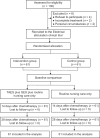Effect of Electrical Stimulation on Gastrointestinal Symptoms in Lung Cancer Patients during Chemotherapy: A Randomized Controlled Trial
- PMID: 33850958
- PMCID: PMC8030592
- DOI: 10.4103/apjon.apjon_61_20
Effect of Electrical Stimulation on Gastrointestinal Symptoms in Lung Cancer Patients during Chemotherapy: A Randomized Controlled Trial
Abstract
Objective: The objective was to evaluate the effects of transcutaneous acupoint electric stimulation (TAES) and gastric electrical stimulation (GES) on cancer patients with chemotherapy-induced gastrointestinal (GI) symptoms.
Methods: A total of 122 lung cancer patients receiving chemotherapy were assigned randomly to the following two groups: control group (usual care group, n = 61) and intervention group (TAES plus GES, n = 61). TAES involved two acupoints such as Neiguan (PC6) and Zusanli (ST36). GES was performed at gastric pacing sites on the body surface such as the places of projection of gastric antrum and corpus on the body surface. GES was performed on these sites for 14 days continuously (25 min every time, once daily). The effects of TAES and GES on GI symptoms were assessed using the Memorial Symptom Assessment Scale on the day prior to chemotherapy (time point 1) and days 14 (time point 2) and 28 (time point 3) after chemotherapy.
Results: No significant differences in the demographic and disease-related variables were detected between the two groups. Differences in symptom occurrence and severity at time point 1 were not statistically significant between the two groups (both P > 0.05). At time points 2 and 3, GI symptoms such as loss of appetite, nausea, vomiting, diarrhea, and constipation in the stimulation group had statistically significantly improved compared with the control group (all P < 0.05).
Conclusions: TAES and GES were efficacious in relieving GI discomfort in lung cancer patients after chemotherapy. TAES combined with GES is a safe and easy-to-use tool to manage GI symptoms in practice.
Keywords: Chemotherapy; gastric electrical stimulation; gastrointestinal symptoms; lung cancer patients; transcutaneous acupoint electrical stimulation.
Copyright: © 2021 Ann & Joshua Medical Publishing Co. Ltd.
Conflict of interest statement
The corresponding author, Prof. Yongyi Chen, is the editorial board member of the journal.
Figures
Similar articles
-
Transcutaneous Acupoint Electrical Stimulation on Chemotherapy-Induced Constipation for Non-Small Cell Lung Cancer Patients: A Randomized Controlled Trial.Asia Pac J Oncol Nurs. 2021 Mar 12;8(4):385-392. doi: 10.4103/2347-5625.311129. eCollection 2021 Jul-Aug. Asia Pac J Oncol Nurs. 2021. PMID: 34159231 Free PMC article.
-
Effect of transcutaneous electrical acupoint stimulation combined with palonosetron on chemotherapy-induced nausea and vomiting: a single-blind, randomized, controlled trial.Chin J Cancer. 2017 Jan 10;36(1):6. doi: 10.1186/s40880-016-0176-1. Chin J Cancer. 2017. PMID: 28069044 Free PMC article. Clinical Trial.
-
[Clinical Trials for Thyroidectomy Under Acupuncture-aided Anesthesia by Using Electroacupuncture or Transcutaneous Acupoint Electrical Stimulation of Different Acupoints].Zhen Ci Yan Jiu. 2017 Aug 25;42(4):332-7. Zhen Ci Yan Jiu. 2017. PMID: 29072015 Clinical Trial. Chinese.
-
Treatment of high-frequency gastric electrical stimulation for gastroparesis.J Gastroenterol Hepatol. 2012 Jun;27(6):1017-26. doi: 10.1111/j.1440-1746.2011.06999.x. J Gastroenterol Hepatol. 2012. PMID: 22128901 Review.
-
Clinical Efficacy and Potential Mechanisms of Acupoint Stimulation Combined With Chemotherapy in Combating Cancer: A Review and Prospects.Front Oncol. 2022 Apr 25;12:864046. doi: 10.3389/fonc.2022.864046. eCollection 2022. Front Oncol. 2022. PMID: 35547876 Free PMC article. Review.
Cited by
-
Antitumoral Agent-Induced Constipation: A Systematic Review.Cancers (Basel). 2023 Dec 24;16(1):99. doi: 10.3390/cancers16010099. Cancers (Basel). 2023. PMID: 38201526 Free PMC article. Review.
-
Electrical acupoint stimulation for the treatment of chemotherapy-induced nausea and vomiting: A systematic review and meta-analysis.Heliyon. 2024 May 11;10(10):e30965. doi: 10.1016/j.heliyon.2024.e30965. eCollection 2024 May 30. Heliyon. 2024. PMID: 38799757 Free PMC article.
References
-
- McIntyre A, Ganti AK. Lung cancer-A global perspective. J Surg Oncol. 2017;115:550–4. - PubMed
-
- Kamangar F, Dores GM, Anderson WF. Patterns of cancer incidence, mortality, and prevalence across five continents: Defining priorities to reduce cancer disparities in different geographic regions of the world. J Clin Oncol. 2006;24:2137–50. - PubMed
-
- van Lancker A, Velghe A, van Hecke A, Verbrugghe M, van Den Noortgate N, Grypdonck M, et al. Prevalence of symptoms in older cancer patients receiving palliative care: A systematic review and meta-analysis. J Pain Symptom Manage. 2014;47:90–104. - PubMed
-
- Tong H, Isenring E, Yates P. The prevalence of nutrition impact symptoms and their relationship to quality of life and clinical outcomes in medical oncology patients. Support Care Cancer. 2009;17:83–90. - PubMed
LinkOut - more resources
Full Text Sources
Other Literature Sources





